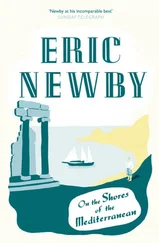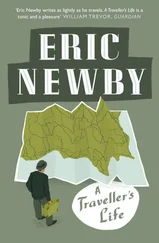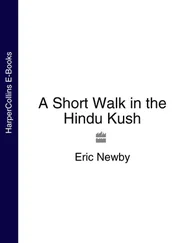At six o’clock the next morning the sky to the east began to glow. Soon it was fierce red. It was as if someone was stoking a furnace. Against it the Siwalik Hills undulated away to the east-south-east as far as the eye could see, like a giant switchback. Flight after flight of duck streamed up the river towards the north. Across the water the stranded trees were like sea monsters hauled out on the shore.
Then the sun rose over the Plains. Three spotted deer came out of the jungle which was still in deep shadow and crossed the river towards us, while a fourth emerged from a belt of long grass that fringed one of the tree-clad islands a quarter of a mile downstream. Seeing us it remained motionless until we got up to look at it. Then it took fright and went off together with the others. The nearness of the temples on either side of the Ganges gorge showed us how far we had really come. One of the two men whom we had met the previous evening arrived with the eggs but it was too late. We had already eaten our breakfast.
CHAPTER FIVE Through the Bhabar
For a considerable distance below Hardwar the bed of the Ganges is composed of boulders … The stream has a far from stable course …
District Gazetteer of the United Provinces , Vol. III, Saharanpur ;
Allahabad, 1909
We set off at nine o’clock. It was hopelessly late but it is always like this at the beginning of a journey. Even when we had bailed the boat dry, and carried out an anxious inspection of the plates and rivets and loaded it up again, there never seemed to be a quorum for the actual departure. Apart from some dents that showed through on the inside as large, ominous swellings, the hull seemed sound enough. Whether or not it was capable of enduring another day of similar battering was another matter.
Although at this point the Ganges was about seventy feet wide, it was still not more than twenty inches deep; but the pebbles which were covered with weed of a greenish-bronze colour seemed smaller and, foolishly, thinking that they would soon vanish altogether, we congratulated ourselves on having done so well.
As soon as we set off we went aground. This was a bad patch. There were three rapids one above the other, each preceded by its own dreary shoal through which we manhandled the boat swearing monotonously. Half way down the third rapid, a fast exciting ride, we hit a large rock head on; the stern reared in the air, a bedding roll went over the side and was rescued by Jagannath as it started to go downstream; the boat broached-to; the gunwales went under and it began to fill with water. We slithered out, righted it, pulled the head round and went down the rest of the way with our stomachs on the gunwales and our feet dragging on the bottom; ending up as we always did in a deep, calm pool of cold water; this time in the lee of an island under a high steep bank of silt and sand to the edge of which a number of stunted trees clung by the last of their roots.
We were in the tract called the Bhabar (the porous place). Here the torrents from the Siwaliks lost their steepness and flattened out, depositing the rocks and boulders which had been making life such hell for us ever since we set off. All the time, on its passage through the Bhabar, the Ganges, already enfeebled by the loss of the vast quantities of water that were drawn from it into the Upper Ganges Canal, was being deprived of even more of its strength as a proportion of it sank into the dry limestone and percolated away. Somewhere further downstream, the water would emerge again to give fresh impetus to the river, but we needed it here and now. With the onset of winter and the dry season the water coming down from the Himalayas was diminishing rapidly. Each day the level of the river fell an inch or more. In a week’s time there would be no water at all in some stretches we had passed through. We were engaged in a race with a dying river which threatened to leave us high and dry, a race which we might have lost without knowing it.
At the end of a short reach in which we were able to use the oars, we went aground in a place where the stream divided itself into three parts. All were equally uninviting. They all began with waterfalls; none gave any indication of which was the principal one, or, whether it bore any relation to the others. It was a problem that from now on was to be with us constantly.
For the purpose of navigation the map was useless. The scale was a quarter inch to the mile. The original survey had been made in 1917 by the Survey of India, and it had been published in 1924 with corrections up to 1950 but only so far as roads, railways, tramways, canals, car tracks and tube wells were concerned. ‘The course of the Ganges River is liable to continual change owing to the shifting of the river bed,’ a note on the map stated. Because of the fighting with China the Indian Defence Regulations were so stringent that it was impossible to buy a large-scale map of any kind in India – I had brought this one with me from England. We could scarcely be accused of being unprepared but for all we knew the right hand channel might be the Banganga, another river altogether. There was no way of knowing. The jungle on the left bank which up to now had extended to the water’s edge had receded and was invisible as was the bank itself; the right bank was equally so. We were somewhere in the middle.
The Banganga is really a backwater of the Ganges; it is said that in ancient times it may have been its bed. Completely unfordable in the rains, it takes off from the parent stream about four miles south of Kankhal on the right bank – we were still not more than four miles from the temple of Daksheshwara – and from this point meanders inconsequentially through the Khadir, the lowland of Saharanpur, in which the principal crop is unirrigated wheat, and through wastes of sand, savannahs of tall grass and marshland before rejoining the Ganges some thirty miles downstream, in the district of Muzaffarnagar, during which it covers at least three times this distance. If we ended up in the Banganga, which at this season must have already reached a point nearing extinction, it would take more than the thirty-two men whom we had employed at Hardwar to carry the boat from the canal to the Ganges to put us on our way again.
The Ganges Canal was the brain-child of Captain Proby Cautley of the Bengal Engineers. He was convinced that it was possible to get water out of the Ganges and into the Doab, 10 the land between the Jumna and the Ganges, an immense area which suffered from frequent and terrible famines. He made his first survey in 1836.
Every kind of difficulty had to be overcome: orders and counter-orders came from the authorities, civil and military, in bewildering succession. One moment it was to be an irrigation canal, next for navigation only. Then it was not to be built at all; notwithstanding the fact that the East Jumna Canal which had originally been built by the Mughals in the eighteenth century had been extremely successful in combating famine in the country which it passed through. It was said that earthquakes would destroy the viaducts, that miasmas would hang over the irrigated land, that malaria would become rife and that the navigation of the Ganges would be affected. (The last objection was the only one that proved to be right.)
The builders laboured under the most fearful difficulties. Rain destroyed the brick kilns and the unbaked bricks along the whole line of works. Often the wooden pins which marked the alignments on which the excavations had to be made were knocked down by cattle or else stolen by the local inhabitants. There were also the problems of working so far from the base at Calcutta, 1,000 miles away. There was no railway in those days. It was found, for instance, that the steam engine which had to be sent to them at Roorkee had been manufactured the wrong way round for the building into which it was intended to fit.
Читать дальше












